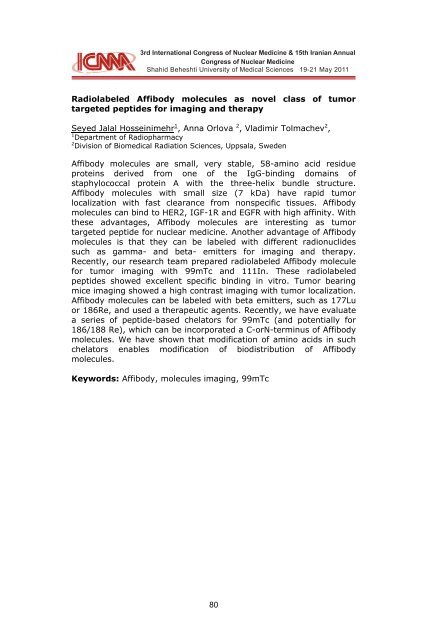Panel Disdussion
Panel Disdussion
Panel Disdussion
You also want an ePaper? Increase the reach of your titles
YUMPU automatically turns print PDFs into web optimized ePapers that Google loves.
3rd International Congress 3rd International of Nuclear Congress Medicine of Nuclear & 15th Medicine Iranian Annual & 15th Iranian Congress Annual of<br />
Nuclear Congress Medicine of Nuclear Medicine<br />
Shahid Beheshti Shahid Beheshti University University of Medical Sciences of Medical 19-21 Sciences May 201119-21 May 2011<br />
Radiolabeled Affibody molecules as novel class of tumor<br />
targeted peptides for imaging and therapy<br />
Seyed Jalal Hosseinimehr 1 , Anna Orlova 2 , Vladimir Tolmachev 2 ,<br />
1 Department of Radiopharmacy<br />
2 Division of Biomedical Radiation Sciences, Uppsala, Sweden<br />
Affibody molecules are small, very stable, 58-amino acid residue<br />
proteins derived from one of the IgG-binding domains of<br />
staphylococcal protein A with the three-helix bundle structure.<br />
Affibody molecules with small size (7 kDa) have rapid tumor<br />
localization with fast clearance from nonspecific tissues. Affibody<br />
molecules can bind to HER2, IGF-1R and EGFR with high affinity. With<br />
these advantages, Affibody molecules are interesting as tumor<br />
targeted peptide for nuclear medicine. Another advantage of Affibody<br />
molecules is that they can be labeled with different radionuclides<br />
such as gamma- and beta- emitters for imaging and therapy.<br />
Recently, our research team prepared radiolabeled Affibody molecule<br />
for tumor imaging with 99mTc and 111In. These radiolabeled<br />
peptides showed excellent specific binding in vitro. Tumor bearing<br />
mice imaging showed a high contrast imaging with tumor localization.<br />
Affibody molecules can be labeled with beta emitters, such as 177Lu<br />
or 186Re, and used a therapeutic agents. Recently, we have evaluate<br />
a series of peptide-based chelators for 99mTc (and potentially for<br />
186/188 Re), which can be incorporated a C-orN-terminus of Affibody<br />
molecules. We have shown that modification of amino acids in such<br />
chelators enables modification of biodistribution of Affibody<br />
molecules.<br />
Keywords: Affibody, molecules imaging, 99mTc<br />
80
















